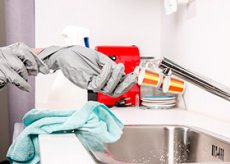New publications
What are the dangers of a kitchen towel?
Last reviewed: 02.07.2025

All iLive content is medically reviewed or fact checked to ensure as much factual accuracy as possible.
We have strict sourcing guidelines and only link to reputable media sites, academic research institutions and, whenever possible, medically peer reviewed studies. Note that the numbers in parentheses ([1], [2], etc.) are clickable links to these studies.
If you feel that any of our content is inaccurate, out-of-date, or otherwise questionable, please select it and press Ctrl + Enter.

It is believed that a huge number of bacteria are contained in a dish sponge. But is a regular kitchen towel much safer?
Not long ago, Scientific Reports published an article stating that 1 cm3 of a dish sponge can contain more than 5*1010 microbial cells, including pathogenic ones.
A new project by scientists from the University of Mauritius involved counting bacterial pathogens on the surface of a kitchen towel. It is not surprising that such an item is not particularly clean either. The researchers selected a hundred towels that had not been washed for 4 weeks, after which they tried to determine the microorganisms that lived on them in the laboratory. It was discovered that pathogenic microbes were indeed present on every second towel. Moreover, the exhibits taken from families with many children were more “infected”.
The scientists also announced the following information: it turned out that those devices that were used simultaneously for wiping plates and hands were more contaminated with bacteria than those that were used for one purpose (for example, only for dishes). And one more nuance, which is quite logical: a damp towel was more contaminated than a dry one.
Did the items for wiping hands and dishes pose an infectious hazard?
The scientists summarized the results of the project at the regular conference of the Microbiological Society. In their own presentation, they reported that in more than 70% of cases, the main bacterial representatives on the towels were microorganisms that are part of the normal flora of the human intestine. For example, non-pathogenic strains of E. coli and microorganisms belonging to the genus enterococci were found everywhere.
Fourteen percent of the towels were infected with Staphylococcus aureus. Scientists have long known about this strain, which is resistant to antibacterial drugs. It is called MRSA, or methicillin-resistant Staphylococcus aureus: it can provoke the development of many diseases, sometimes even very dangerous ones. However, such a microorganism is almost always present on human skin or mucous tissues of the respiratory system, without the development of painful processes.
It is noteworthy that scientists did not find standard pathogens of intestinal infectious diseases on kitchen items - for example, salmonella, campylobacter, or pathogenic variants of E. coli. It can be noted that the same Staphylococcus aureus can, under certain conditions, cause food poisoning when it gets into food. But it can also get there through unwashed hands.
What conclusion did the researchers come to?
Of course, there is a considerable risk that bacteria can spread through dirty towels. However, this risk should not be exaggerated. Moreover, it is rare for any of us to wash such regularly used items once a month: usually it happens much more often.
Scientists advise: more attention should be paid to observing basic hygiene rules.
